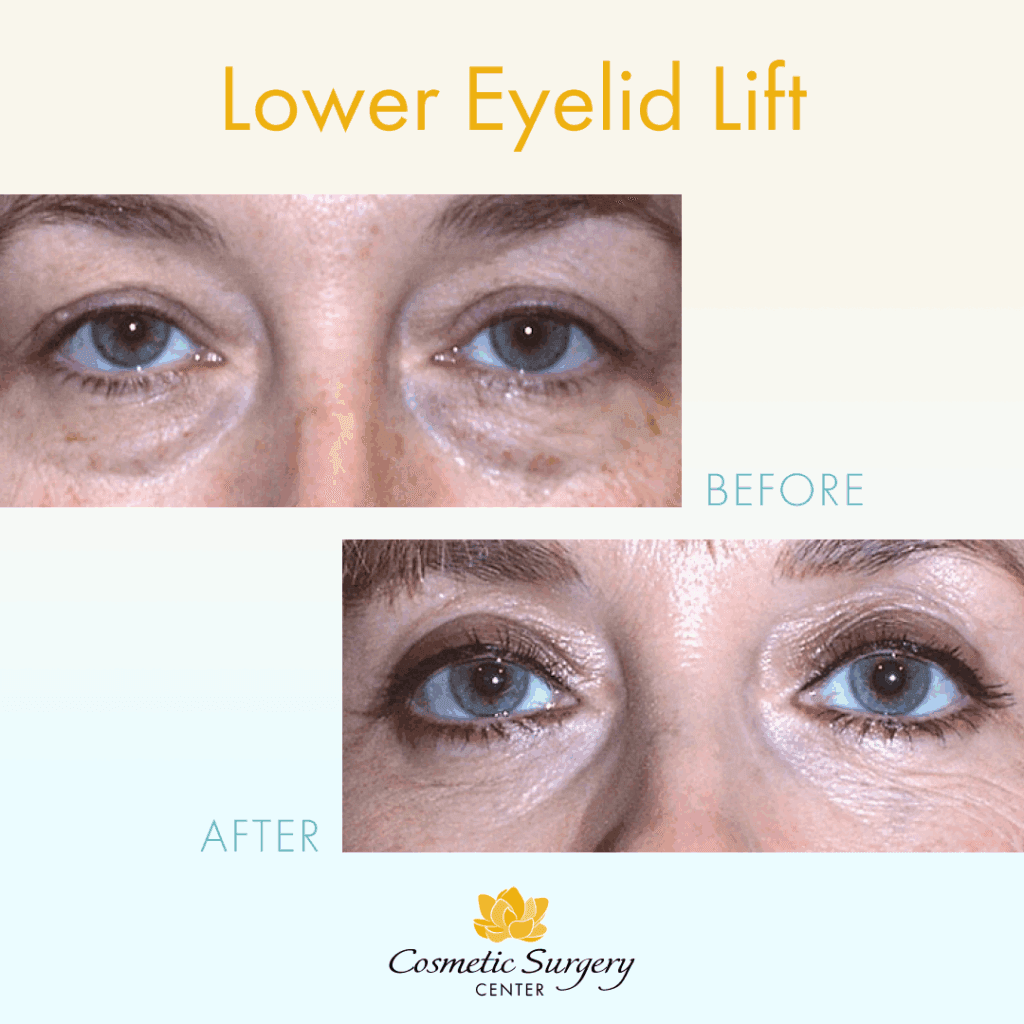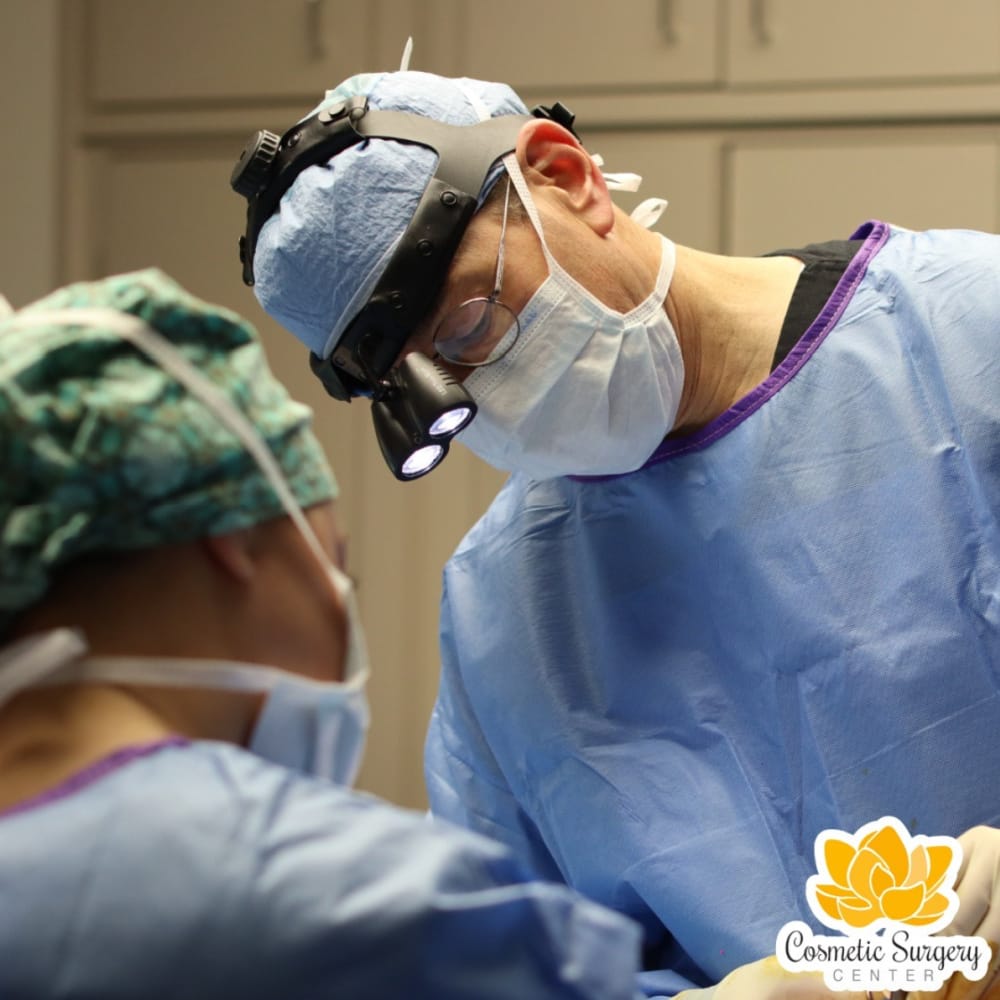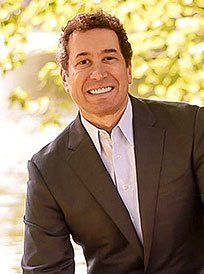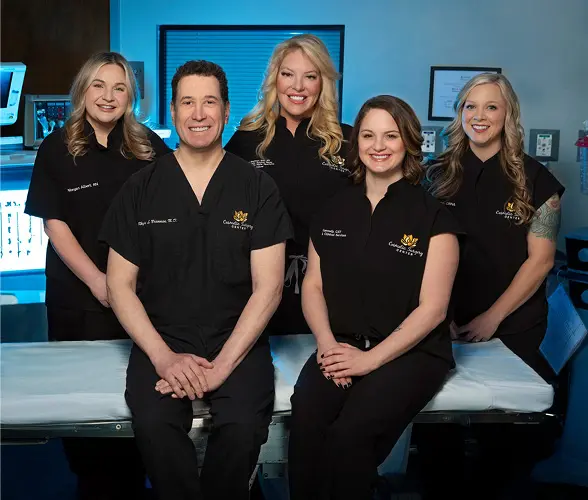Eyelid Surgery in Little Rock, Arkansas
Blepharoplasty, or eyelid surgery, is a procedure that removes fat deposits and excess skin from the upper and lower eyelids. The surgery can correct drooping upper eyelids and puffy bags below your eyes – conditions that make one look old, tired, and stressed out. In some cases, these conditions may even hinder your vision.
Eyelid surgery can be done alone or in conjunction with other facial surgery procedures—Little Rock facelift or brow lift patients find that they can achieve enhanced facial rejuvenation by combining these surgeries.

Who Can Benefit From Eyelid Surgery?
Proper candidates for eyelid surgery are physically healthy, realistic in their expectations, and exhibit conditions like the following:
- Bags under the eyes
- Excess skin on the upper eyelids
- Sagging upper eyelids
- Folds of skin around the eyes
- Impaired vision due to eyelid tissue
People who experience medical conditions such as hypothyroidism, Graves’ disease, dry eye, high blood pressure, circulatory disorders, cardiovascular disease, diabetes, detached retina, or glaucoma should check with their ophthalmologist before considering eyelid surgery.

Your Surgical Consultation
The initial consultation with your surgeon is very important. Little Rock cosmetic surgeon Dr. Branman will need your complete medical history, so check your own records ahead of time and be ready to provide this information. You will also be required to have a recent eye exam and have the results sent to our office prior to the surgery. Dr. Branman will evaluate your eyelids and help determine which surgical interventions are necessary. He will also explain the surgical techniques and anesthesia used and answer any questions you may have regarding the risks, benefits, or cost of eyelid surgery. Most insurance policies don’t cover eyelid surgery unless you can prove that drooping upper eyelids interfere with your vision. You may want to check with your insurer. While you’re making preparations, be sure to arrange for someone to drive you home after your surgery, and to help you out for a few days if needed.
Eyelid Lift Procedures: What to Know
Eyelid surgery usually requires less than one hour in our office-based facility or an outpatient surgery center. The procedure is performed under local anesthesia, which numbs the area around your eyes. General or intravenous sedatives are also used. Dr. Branman makes ultra-precise incisions that follow the natural creases of your upper eyelids, and just below the lashes in the lower lids. Working through these incisions, he separates the skin from underlying fatty tissue and muscle, removes excess fat, and often trims sagging skin and muscle. The incisions are then closed with special sutures.
In cases where the patient exhibits no excess skin but has a pocket of fat beneath the lower eyelids, Dr. Branman may perform a transconjunctival blepharoplasty, during which an incision is made inside the lower eyelid, leaving no visible scar. This technique is more common with younger patients who have thicker, more elastic skin.
Eyelid Surgery at Little Rock Cosmetic Surgery Center
In this video, our very own Registered Nurse walks you through the eyelid surgery process – from prepping for your surgery through your full recovery. For more information about surgical procedures at our surgery center, please watch our general surgery video below.
Video transcript »
Here’s the edited version of the text:
“Hey guys, April Gring here, registered nurse at the Cosmetic Surgery Center. Today we’re going to be talking about blepharoplasties. There are different ones that Dr. Branman performs: there’s an upper, a lower, and a complex blepharoplasty. We’ll let you know exactly what you’re getting whenever you consult with him so you’ll know a little bit more about that. But it kind of all has the same information—some of your sutures will dissolve, and some will actually have to be taken out, but that’s really the only difference.
If you haven’t already watched the general surgery information video, go ahead and watch that before we get into this video. This one is kind of long, so just bear with me if I have to read off the page a little bit more. We’ll go ahead and start.
The items you’ll need at home are your lab work and an eye exam. You’ll need to get that before surgery, and we’ll need to look it over and make sure everything checks off before you get surgery. You’ll also need prescription medications, and you’ll get those at your pre-op. But you’ll need to go to Walmart or Walgreens or somewhere to pick up some Genteal Gel and Genteal Drops—that’s G-E-N-T-E-A-L, I’m sorry. You’ll need a bag of frozen peas and some small Ziploc snack-size baggies to put those frozen peas in, and you’ll put those over your eyes after surgery. Also, you’ll need some hydrogen peroxide and Q-tips to clean your incision sites with, and of course, sunscreen, a hat—stuff like that, or something to cover up your incision sites and make sure the sun’s not getting on them.
We already talked about this during the general surgery information video, but I want to reiterate it here: bring a button-up or zip-up top that we can put you in because we don’t want to bring anything over your head and get it in your eyes or anything after surgery. This is a surgery that you have to stop smoking six weeks before and six weeks after.
That’s really it on what you need to know before. Now we’ll talk about after the procedure.
After your procedure, you’re going to restart your antibiotic medication and your Arnica medication with a light meal to avoid any nausea after surgery. You’re not going to sleep with a fan on because this can dry out your eyes more after surgery, so no fans—I know that’s hard. Then, to minimize swelling, oozing, and bruising, try to suppress any forceful coughing or sneezing for at least seven to ten days after your surgery. You’re going to keep that ice pack or the frozen peas over your eyes for about 12 to 24 hours after surgery. If it’s getting too cold, you can put like a little Kleenex on and then put it on there, or some little gauze pads—whatever works for you. You’re also going to sleep for the first week after your surgery with your head elevated. That could be in a recliner or in your bed propped up on two to three pillows. That’s just going to help with swelling also. No lifting anything greater than 10 pounds after surgery, avoid bending forward a lot, and avoid any strenuous or aerobic activity for about four weeks after surgery. If bruising does occur, it should be gone within two to three weeks.
Now, this is very important, y’all—this is talking about a complication that could result in blindness. If you ever notice any severe pain and swelling in one or both eyes or decreased vision, then definitely give us a call immediately. This has never happened, but the usual cause of this would be abrupt bleeding behind the eye, and it normally would happen within that first 12 hours after surgery. So, if you ever notice any of those signs, give us a call. A low-grade fever isn’t too abnormal after surgery—just take some Tylenol, increase your fluid intake, and if it doesn’t go below 101.5°F, then give us a call. If there’s any sudden profuse bleeding, like on your incision area, then definitely give us a call for any of that. You might have a little bit of oozing out of it for the first 24 to 72 hours, and that’s normal, so no worries there.
Like I said, you are going to need a hat, sunscreen, and to avoid the sun for about 6 to 12 months. That is just going to protect your incisions from any darkening colors or pigments. So be sure and do that. Don’t drive and take your pain medication, obviously. No using eye makeup until Dr. Branman gives you the okay, and that’s normally for about two weeks after surgery. Obviously, no stretching, pulling, or tugging on your eyelids for four weeks. You’ll have your next appointment after surgery—we’ll give you your next appointment, and normally it’s within about four to six days after your surgery.
This is talking about the eye drops or the eye gel. At night, you are going to apply the Genteal Gel in both eyes for the first several nights before you go to bed. That is just going to help with that eye dryness. The drops you can use throughout the day if your eyes feel dry, but make sure you’re buying that specific kind. Don’t use any of the eye drops that get rid of redness.
You can start wearing eyeglasses again at any time after surgery, just no contact lenses for about three weeks. Normally, Dr. Branman will let you know whenever you can start using your contacts again, but it’s normally about three weeks.
Now, we’re going to go over what to expect after surgery. Discomfort is normally just minimal and easily controlled with pain medication. Like we said, you’ll have mild to moderate swelling and bruising in the eyelids and tissues surrounding the eyes, maybe even the cheeks. It just varies—if you’re a big bruiser normally, you’re probably going to be a big bruiser in this surgery. Decreasing salt intake and sleeping with your head elevated will help with that swelling.
Part of the surgery involves a small amount of blood-tinged fluid oozing from the incisions for the first 24 to 48 hours—this is normal. Just be sure not to blot too hard on your eyes if you notice that, as it might displace the steri-strip dressing if you have one on there. Your incision area will be a little bit reddened and feel firmer to the touch at first. It takes about a year for the incisions to mature or get lighter and softer. Like I said, avoid sun exposure, and that will help them not hyperpigment. You might have a little numbness of the eyelids for the first several months until the sensory nerves regenerate. Sometimes, you might notice a little bit of burning in the eyes when shampooing, dry eyes upon waking after sleep, and occasional blurriness when reading. That’s all due to swelling and early wound healing and should subside with time, usually in a month or two.
As far as care of your incisions, if you have that little steri-strip on your eyelid, leave it there until your post-op visit, which is normally about five days out. If you don’t have a steri-strip there, then clean the incision area with a Q-tip and peroxide twice daily—morning and afternoon. Most of the time, your sutures will dissolve on their own, but on occasion, non-dissolvable sutures will be used and will be removed in our office.
As we already said, your post-op visits—the first one will be about four to six days out, and Dr. Branman will tell you any other appointments you need to come to for follow-ups after that. He’ll make those for you based on your healing and everything.
Really, that’s about it, y’all. There’s a couple more things in here that just go over the consents, but you’ll get this little packet at your pre-op before surgery. Thanks, guys—we can’t wait to see you!”
After Your Eyelid Surgery
During the recovery period, patients need to keep the head elevated for several days and use cold compresses to reduce swelling and bruising. The amount of bruising will vary; for some patients, it lasts 2 weeks and for others, it may be as long as 4 weeks. The eyes will need to be cleaned regularly, as they may be gummy for a week or so. If you experience dryness of the eyes or eyelids, Dr. Branman may recommend eye drops. It is common for patients to experience some excessive tearing, sensitivity to light, and temporary blurriness of vision after eyelid surgery. We will follow your progress very closely for the first week or two.

The stitches will be removed within one week. Once they’re out, swelling and bruising will gradually subside and you’ll start to look and feel better. Most patients resume their normal routine in 7 to 10 days. By then, depending on your rate of healing, you may be able to wear makeup. After ten days, you might still have sensitive eyes, so it helps to wear sunglasses and sunblock when outdoors. During recovery, it is important to avoid activities that raise your blood pressure, including bending, lifting, and rigorous sports. It is also recommended that you avoid sodium or alcohol products, to prevent fluid retention.
“As a middle-aged woman I simply wanted to look as youthful and energetic as I still felt inside. Dr. Branman listened to me and understood exactly what my goals were. Also, as a registered nurse myself it was very important to me to find a surgeon that I had complete confidence in. I truly found that in Dr. Branman. Thanks to Dr. Branman people no longer ask me if I am tired when I am not. Would I do it over again? Yes.”
Eyelid Lift Risks
We take all necessary steps to reduce the likelihood of complications from surgery. Nevertheless, with any operation, complications are possible. Infections can occur, as can a reaction to anesthesia.
Following instructions before and after surgery can reduce your risk. Relatively minor complications associated with eyelid surgery include blurred vision for a few days, temporary swelling at the corner of the eyelids, and a slight asymmetry in healing, or scarring. Very small whiteheads can appear after the stitches are removed, but Dr. Branman can remove them easily with a fine needle.
It is possible that some patients experience difficulty closing their eyes when they sleep; in rare cases, this condition may be permanent. Another very rare complication is ectropion, which results in a pulling down of the lower lids. In this case, another procedure may be necessary.
Why choose Dr. Branman for your Little Rock eyelid lift
Dr. Rhys Branman is an elite facial cosmetic surgeon in Little Rock. Board certified by both the American Board of Cosmetic Surgery and the American Board of Maxillofacial Surgery, Dr. Rhys L. Branman has the intricate knowledge of facial anatomy essential for achieving natural-looking results, along with over 20 years of experience performing eyelid surgery.
Schedule a consult to learn more
If you’re ready to talk to a cosmetic surgeon about your eyelid lift options, we invite you to call or contact us for a consultation with expert facial surgeon Dr. Branman. He will listen to your goals and concerns, answer your questions, and help you decide the best approach to make the improvements you have in mind.
Dr. Branman has extensive experience in performing facial procedures and has been helping Little Rock, Arkansas blepharoplasty patients meet their goals since 1998. He would be happy for you to come in for a consult to learn more about your facial plastic surgery options.
Areas Served: